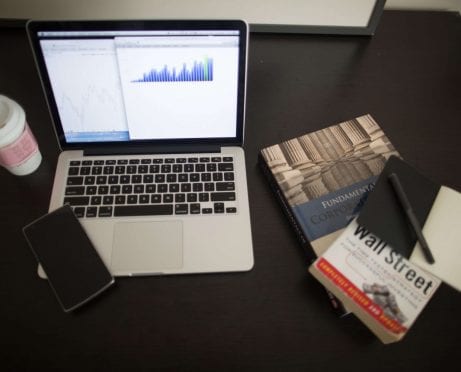
Emma Finnerty
This is the fourth installment of Stock Market for Beginners, our six-part series on investing and the stock market. You can read the previous piece, Do I Need a Financial Advisor?, here.
Some experienced investors will tell you that investing in stocks is about as exciting as watching grass grow. That’s because, most of the time, investing means doing nothing.
You could, of course, choose to anthropomorphize your investments. You could celebrate stocks that gain as Heroes and decry those that decrease in value as Losers. But experienced investors don’t do that. Instead, they evaluate their investment processes and stock strategies, consider various risk factors, and watch the math work.
Do you believe me when I say that investing in stocks is like watching math unfold in real time? Most people don’t. The media don’t stick to the “it’s just math” line.
Scandals, high-frequency trading, and dramatic market movements make the headlines. Unless you’ve been living in a cave you know about how a Reddit group influenced trading of at least two stocks, GameStop and AMC Entertainment.
A few people made some money, but I bet the majority who followed the herd without understanding market fundamentals may not have fared as well.


In the media’s hands, Wall Street can look like a refined version of Las Vegas.
Some day-traders seem to treat investing like gambling or playing a video game. They’re quick to post their (sometimes incoherent) thoughts on the “Wall Street Bets” subreddit or in a Facebook group. And you probably have a crazy uncle who lost thousands on a hot investment pick.
The narrative might go something like this: I saved $15,000, and I worked hard for that money. If I lost $10,000 overnight in the stock market, I would feel devastated. When those are your investing stories, you probably don’t want to risk your hard-earned dollars gambling in the “Wall Street Casino.”
But should you focus only on the downward risk? Don’t ignore the fact that without strategic investment, you could lose big — thanks to the risk of inflation.
Yet, day-trading carries with it considerable risk. “The inherent risk of day- trading is that you are essentially making bets, however well-informed, on how the speculating of other investors in the market will affect the daily price fluctuations of a given asset or financial instrument,” says Bryce Welker, a certified public accountant and founder of CPA Exam Guy.
“As we saw with the GameStop fiasco of early 2021, many of the inexperienced investors who waded into the day-trading game and pit themselves against the hedge funds and institutions who do this for a living — and rarely lose — without understanding what they were up against, were wiped out,” Welker says.
Those small investors and their losses rarely make the news, but they are real.
“Day-trading requires not only a lot of market savvy, making it unsuitable for new investors, but also the technological infrastructure to be able to place trades and have them filled on a moment’s notice,” Welker continues.
“The upside, and what attracts so many to day-trading, is that the flip side of the high risk is the potentially high reward,” Welker adds. “Day-trading can result in large returns on investment in short periods of time with relatively little effort.” At the end of the day, day-trading is not only perilous for new investors, but any investor.
Strategic Investment and the Inflation Casino
The Federal Reserve influences the supply of money in the United States. Its stated goal is to increase core inflation (measured by a fancy statistic called Core PCE) by 2 percent per year. The Fed meeting its target of 2 percent inflation also means that your money loses purchasing power at the same rate — 2 percent inflation means the same number of dollars will buy 2 percent less.
For most people, a guaranteed 2 percent loss is better than a possible 50 percent loss. But your money — if left alone — loses an average of 2 to 3 percent of its purchasing power every single year. Moreover, there are years where inflation may be higher than this average.
At 2 percent inflation, in 35 years’ time, you would need $15,000 to purchase something that costs $7,500 today. Given this scenario, I would say that it’s riskier if you don’t invest. This is why I like to focus on “positive” risks instead of “negative” ones when I think about investing in stocks.
Making a Strategic Investment vs. Gambling
Investing — in the proper sense of the word — is based on mathematical expectancy. If you take the same “bet” enough times, you know that you’ll come out ahead. If investing were like gambling, it might look something like this:
Let’s say that you went to Las Vegas to play roulette. On the roulette wheel, black comes up half the time and red comes up half the time. (Technically, this isn’t exactly true, because the ball could end up on zero or double zero, which are green. But we’ll ignore that for now.)
If you bet $1 on black and the ball lands on black, you get $2. If the ball lands on red, you lose your dollar. So let’s say that you bet one buck 10 times.
How much would you expect to “earn” in this situation? Nothing. You might walk away $10 richer, but you might also walk away $10 poorer. Or you might walk away with exactly $10. The odds of making money or losing money are the same.
Now, consider a different payout schedule. Let’s say that betting on black gives you $2, so you’d have $3 total if your ball lands on black. Red remains at the $1 payout. Would you bet black or red?
A gambler might bet on red based on their gut, but an investor would know to choose black every time.
The odds of the ball landing on black are the same as before, but the payout is bigger. Thus, the mathematical expectancy of a return is higher. The more bets on black you make, the more likely you’ll win more money.
Similarly, successful investors make money by focusing on the investing process, rather than through sheer gambling. A process orientation allows investors to “take the same bet” over and over.
By “take the same bet,” I don’t mean buying the same stock, mutual fund, or exchange-traded fund (ETF). I mean knowing what one’s (short-, medium-, and long-term) goals, risk tolerance, and time horizon are, to start. Someone who is 55 may choose to invest more conservatively than someone who is 25 and has more time to weather market volatility.
What is not difficult to dispute — investing done with education and a plan isn’t gambling. It’s not hoping for a return. Strategic investment means knowing that you’ll make a return over time. Gamblers hope, but investors have a solid understanding of the risks and the upside.
Dollar-Cost Averaging and Other Stock Strategies
One of the simplest processes for investing involves dollar-cost averaging in broad-based market indexes.
Dollar-cost averaging occurs when investors choose to contribute “a specific amount of money into a mutual fund, ETF, or stock each month over a long period of time,” says Haley Tolitsky, a certified financial planner with Cooke Capital. “This happens behind the scenes in your 401(k) plan.”
Dollar-cost averaging can be implemented in many, if not all, asset classes.
“Dollar-cost averaging is a great way to build wealth over time, because of the difficulty associated with timing the market, and this strategy allows you to purchase fewer shares when the market is high and more shares when the market is low and stocks are on sale,” Tolitsky adds.
This means that you invest the same amount of money every paycheck in a fund, whether that fund is a low cost index fund or a high cost actively managed fund.
The process may sound simple, but it’s incredibly effective, which is why so many investors use the strategy.
There are also apps like Acorns that encourage you to set up an investment account using as little money as the spare change in your wallet. Though no app is perfect, and there’s no substitute for learning the basics, fintech has played a role in democratizing investing.
Concepts like investing your spare change through an app are a welcome alternative to needing a minimum amount to open a brokerage account.
Active management and stock picking might be right for you, but don’t dabble in those areas until you’ve had time to learn about the process first. I recommend investigating more complex processes with Investopedia’s stock market simulator.
This will help you learn about strategic investment and understand the math and process without putting your money at risk.
The Bottom Line
Do your homework and be patient. When done well, investing can help secure your future. And with the right strategy, it will always win in an “investing versus gambling” showdown.
This is the fourth installment of Stock Market for Beginners, our six-part series on investing and the stock market. To read the next piece, Investing Tips, click here.
Additional reporting by Ellie Schmitt and Lukas Shayo.
Past performance is not a predictor of future results. Individual investment results may vary. All investing involves risk of loss.
Best Investing Apps of 2021
Earn up to $3,000 bonus cash when you open a self-directed account















